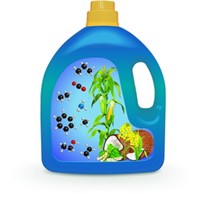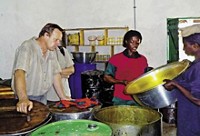Advertisement
Grab your lab coat. Let's get started
Welcome!
Welcome!
Create an account below to get 6 C&EN articles per month, receive newsletters and more - all free.
It seems this is your first time logging in online. Please enter the following information to continue.
As an ACS member you automatically get access to this site. All we need is few more details to create your reading experience.
Not you? Sign in with a different account.
Not you? Sign in with a different account.
ERROR 1
ERROR 1
ERROR 2
ERROR 2
ERROR 2
ERROR 2
ERROR 2
Password and Confirm password must match.
If you have an ACS member number, please enter it here so we can link this account to your membership. (optional)
ERROR 2
ACS values your privacy. By submitting your information, you are gaining access to C&EN and subscribing to our weekly newsletter. We use the information you provide to make your reading experience better, and we will never sell your data to third party members.
Sustainability
Solid body wash comes without packaging. But does that make it eco-friendly?
Cosmetics firms appeal to plastic-free consumers with the hybrid of bar soap and liquid body wash
by Carmen Drahl
May 9, 2018
| A version of this story appeared in
Volume 96, Issue 20

When Beth Terry takes a shower, she doesn’t reach for a plastic bottle of body wash. She’s still troubled by an article she read 11 years ago with graphic imagery of plastic trash in a dead seabird’s belly. The author of the popular My Plastic-Free Life blog has been tracking her personal plastic footprint ever since—with spreadsheets because she’s an accountant by trade—and finding ways to minimize it.

Governments are responding to demands from consumers like Terry. The U.S. in 2015 banned plastic microbeads used as exfoliators in cosmetics and personal care products. Shopping bag fees and restrictions on plastic straws and utensils have taken effect in multiple cities. And a couple of enterprising companies are creating products for consumers who want to swear off plastic packaging altogether. These trends set the stage for solid body wash.
Counterintuitive though it may seem, it’s relatively straightforward to transform a liquid product like body wash into a solid that consumers can pick up off the shelf, sans packaging. But is this newfangled stuff any different from a paper-wrapped bar of soap, which has been around for millennia? And is solid body wash really the environmentally conscious choice?
Bath-product powerhouse Lush has offered solid, packageless versions of shampoo and other toiletries for years. “When Lush began, our founders took a look at products and thought, ‘Do we really need a package for this?’ and found that most often the answer was no,” senior brand and product trainer Erica Vega says. Lush estimates that in 2017, solid shampoo bars prevented 100 metric tons of plastic waste. The firm launched solid body washes for the 2017 holiday season, an additional estimated 4-metric-ton plastic savings. “Most people just think it’s soap, but as soon as you get it wet and wash with it, you can feel the difference,” Vega says. “It’s instantly recognizable as shower gel as it lathers up in your hands.”
Regardless of whether they’re solid or liquid, soap and body wash feel different because they’re chemically distinct, according to Society of Cosmetic Chemists President Perry Romanowski. Every cleanser contains surfactants to help water dissolve and wash away oily filth. The surfactants in soap come from saponification, which is the reaction between a strong base, such as sodium hydroxide, and a fatty acid or triglycerides from vegetable oils or animal fats. Shower gels and body washes, in contrast, contain different surfactants derived from petroleum or plant sources, such as sodium laureth sulfate or sodium cocoamphoacetate. The feel of a given product has a lot to do with its pH, Romanowski explains. The pH of the thin layer of sweat and sebum that sits atop skin is slightly acidic at approximately 5.5, and body washes operate right around there, at pHs between 4 and 6. Traditional soaps can clock in at around pH 9, which Romanowski says can feel drying.
Lush and U.K. firm Bomb Cosmetics use sodium stearate, a saponified fatty acid and common soap ingredient, to thicken and harden solid body wash products. Other compounds would also work, Romanowski says, but sodium stearate is the best option because it’s inexpensive and it’s already used to solidify mainstream personal care products. “If you look at a package of Speed Stick deodorant, you’ll see this is pretty standard technology,” he says. Major multinational brands don’t yet offer solid body wash, and Romanowski fears that a package-free product might droop and deform when exposed to the heat and humidity that can creep into a big-box store’s supply chain. But he points out that big companies have been known to eventually embrace breakout products originating with smaller firms, as happened in the case of sulfate-free shampoo. “It’s not unreasonable to think that packageless products might catch on in the mainstream.”
That’s the kind of trend Terry hopes for, but the blogger’s views have grown more nuanced with time. “When I started, it was really only about cutting back on plastic,” she says. But then she’d go to the supermarket and find herself torn because the organic produce she prefers would be in plastic packaging and the conventional produce would not. It led, she says, to some difficult decisions.

"How do you get squeaky clean in the tub?" This is how they responded via Facebook and Twitter. If you missed the poll but want to weigh in, go to cenm.ag/soappoll.
Sources: Twitter, Facebook
Evaluating which products are most environmentally friendly is not as straightforward as people may think, says Margarida Gama, an expert in cosmetics life-cycle assessment at the international consulting and software firm Thinkstep. And solid body wash is relatively new, so studies are still lacking for this kind of product. Liquid body washes certainly can have their drawbacks. Plastic packaging is indeed a major contributor to toiletries’ environmental impacts, but the formulation, including whether ingredients were made from fossil-fuel-derived feedstocks, has to be considered to perform any comparisons. One study found that liquid soaps for hand washing need about five times as much energy for formulation and roughly 20 times as much energy for packaging production than bar soaps do (Environ. Sci. Technol. 2009, DOI: 10.1021/es901236f). Compared with solid cleansers, liquids usually take up more volume in the trucks that transport them to points of sale, potentially costing more in fuel and emissions.

Body wash overtook bar soap in the U.S. market more than 10 years ago.
Source: Euromonitor International
Bar soaps are not without environmental costs, however. The animal and plant fats in bar soaps must be sourced from somewhere, and frequently, that involves resource-intensive agricultural practices. Biobased surfactants are one of the current cosmetic industry trends, Gama points out, but the fact that the surfactants are biobased does not necessarily mean that they are more sustainable than petroleum-based ones.
It is also important to consider how a person uses the product, Gama says. Does the bottle or pump for a liquid body wash dispense more product than is needed? Which product—bar soap or body wash—takes more water to rinse off? The study comparing liquid hand soap with bar soap suggests that people use more warm water when washing with bar soap, but Gama thinks it’s too big a leap to extrapolate that data to a shower and that further research on consumer behavior patterns is needed.


With so many factors involved in determining an environmental footprint, it’s understandable for consumers to feel overwhelmed when choosing among body cleansers. Gama advises concerned shoppers to get informed. Websites such as Rank a Brand provide information about ingredients that brands use, packaging-reduction initiatives, and more so that people can decide what’s most important to them. Many cosmetic products today are marketed with stories rather than the quantitative figures that can guide decision-making, she says. “Industry should focus both on providing consumers the information they need to make an informed decision and on grounding that information in evidence-based methodologies, such as life-cycle assessment.”
As for Terry, she’s at peace with her product choices, even if they include plastic on rare occasions. She prefers all-natural soaps to body washes, anyway. “I’ve reached the point where I’ve realized that every product that’s created has some environmental impact,” she says. For body wash diehards, she thinks a package-free version might be the greener option. Personal choices matter, she says, and people should make the most informed choices they can. But agonizing over what cleanser to buy probably isn’t as important as taking action that can lead to change on a bigger level, such as contacting local legislators about environmental issues, she adds. “It’s about setting your priorities, making a decision, and letting it go.”





Join the conversation
Contact the reporter
Submit a Letter to the Editor for publication
Engage with us on Twitter